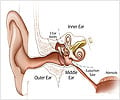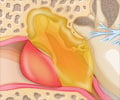Utah and Texas researchers have learned how quiet sounds are magnified by bundles of tiny, hair-like tubes atop hair cells in the ear.
Utah and Texas researchers have learned how quiet sounds are magnified by bundles of tiny, hair-like tubes atop "hair cells" in the ear: when the tubes dance back and forth, they act as "flexoelectric motors" that amplify sound mechanically.
"We are reporting discovery of a new nanoscale motor in the ear," says Richard Rabbitt, the study's principal author and a professor and chair of bioengineering at the University of Utah College of Engineering. "The ear has a mechanical amplifier in it that uses electrical power to do mechanical amplification.""It's like a car's power steering system," he adds. "You turn the wheel and mechanical power is added. Here, the incoming sound is like your hand turning the wheel, but to drive, you need to add power to it. These hair bundles add power to the sound. If you did not have this mechanism, you would need a powerful hearing aid."
The new study is scheduled for publication Wednesday, April 22 in PLoS ONE, a journal published by the Public Library of Science. The first author is Katie Breneman, a bioengineering doctoral student at the University of Utah. The study was coauthored by William Brownell, a professor of otolaryngology (ear, nose and throat medicine) at Baylor College of Medicine in Houston.
The researchers speculate flexoelectrical conversion of electricity into mechanical work also might be involved in processes such as memory formation and food digestion.
Dancing Cells and Hair-like Tubes in Your Ears
Previous research elsewhere indicated that hair cells within the cochlea of the inner ear can "dance" – elongate and contract – to help amplify sounds.
Advertisement
Such flexing converts an electric signal generated by incoming sound into mechanical work – namely, more flexing of the stereocilia – thereby amplifying the sound by what is known as a flexoelectric effect.
Advertisement
In a yet-unpublished upcoming study, Rabbitt, Breneman and Brownell find evidence the hair cells themselves – like the stereocilia bundles atop those cells – also amplify sound by getting longer and shorter due to flexoelectricity.
Rabbitt and Brownell estimate the combined flexoelectric amplification – by both hair cells and the hair-like stereocilia atop hair cells – makes it possible for humans to hear the quietest 35 to 40 decibels of their range of hearing. Rabbitt says the flexoelectric amplifiers are needed to hear sounds quieter than the level of comfortable conversation.
"The beauty of the amplifier is that it allows you to hear very quiet sounds," Brownell says. Rabbit says that because hair cells die as people age, older people often "need a hearing aid because amplification by the hair cells is not working."
Because hair-like stereocilia also are involved in our sense of balance, the flexing of stereocilia not only contributes to hearing, but "also likely is involved in our sense of gravity, motion and orientation – all the things needed to have balance," Rabbitt says.
The new study is part of an effort by researchers to understand the amazing sensitivity of human hearing. Rabbitt says the hair cells are so sensitive they can detect sounds almost as small as those caused by Brownian motion, which is the irregular movement of particles suspended in gas or liquid and bombarded by molecules or atoms.
An Amplifier for All Sorts of Ears
Hair cells are inside the inner ears of many animals. They are within the ear's cochlea, which is the spiral, snail-shell-shaped cavity where incoming sound vibrations are converted into nerve impulses and sent to the brain. Incoming sounds must be amplified because incoming sound waves are "damped" by fluid that fills the inner ear.
Hair cells are about 10 microns wide, and 30 to 100 microns long. By comparison, a human hair is roughly 100 microns wide. A micron is one-millionth of a meter. The hair-like stereocilia tubes poking out the top of a hair cell are each a mere 1 to 10 microns long and about 200 nanometers wide, or 200 billionths of a meter wide.
Brownell says the new study shows how the flexoelectric effect "can account for the amplification of sound in the cochlea."
Stereocilia essentially are membranes that have been rolled into tiny tubes, so "the fact that a membrane can generate acoustic [mechanical] energy is novel," says Brownell. "Imagine hearing a soap bubble talk."
Flexoelectricity in a membrane was noted a few decades ago when a researcher in Europe showed that flexing or bending a simple membrane in a laboratory generated an electrical field. Then, in 1983, Brownell showed that a hair cell from a guinea pig's ear changed in length when an electric field was applied to it in a lab dish.
-section of part of the cochlea, the fluid-filled part of the inner ear that converts vibrations from incoming sounds into nerve signals that travel to the...
Source-Eurekalert
SRM









